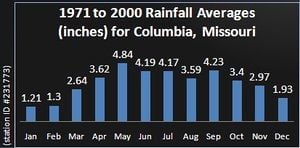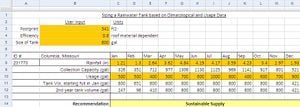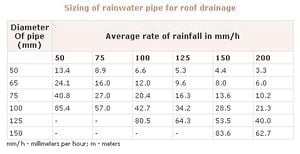
This page describes some basic math for calculating the potential collection of a rainwater harvesting system.
Collection calculations[edit | edit source]
Where:
| Symbol | Description | Units | Notes |
|---|---|---|---|
| V | Volume of collection | gal/time or m3/time | Use this to help determine tank size |
| R | Precipitation | inches/time or mm/time | Collect this data or find it from existing climate data |
| A | Footprint of collection surface | ft2 or m2 | This is horizontal projected area of the collection surface. For a rectangular house, use length times width. |
| e | Efficiency of collection surface | unitless | .75 soil,.8 average,.95 metal[1] |
| K | Conversion | 7.48 gal/ft3 or SI | You can also combine the 1ft/12in conversion for the precipitation data here. |
US example[edit | edit source]

A 1900 square foot house with slanted shingle roof in Columbia, Missouri can collect a potential 2500 gallons in the month of March:
- March total volume = 2500 gallons for the month
SI example[edit | edit source]
A 100 square meter house with concrete roof in Santo Domingo, Dominican Republic can collect a potential 13,050 liters (3,447 gallons) in the month of July:

- July total volume = 13,050 liters for the month
Spreadsheet calculator[edit | edit source]

Here is a link to a spreadsheet that takes into consideration the size of tank and the use of the water. The spreadsheet accepts as input the precipitation, collection area, efficiency of the roofing material and the use in order to output the collection amounts and warnings if the need outweighs the availability for a month or if the availability is declining over time.
Online calculator[edit | edit source]
A Rainwater Collection Calculator assists in designing a rainwater catchment system. Instructions on how to use the tool as well as the basis for all calculations are presented at Rainwater Collection Calculator.
Another useful calculator is the rainwater collection calculator from Good Calculators, which allows you to estimate the rainwater harvesting potential within a calendar year based on monthly historical rainfall data. This rainfall collection calculator uses the National Climatic Data Center's (NCDC) 30-year average rainfall data for the area of interest.
Tips[edit | edit source]
- Keep in mind that this can be calculated per year, month, day, etc. Errors result from low time resolutions because the tank will be filling from rain and emptying from use midcycle. High time resolutions are hard to come by and require more calculations.
- For a quick figure you can use the rule of thumb of 0.5 gallons per square foot per inch of rain.[2]
- For an even quicker figure you can use SI units with this calculation: The roof efficiency (e.g. 0.8) in liters per m2 of roof (equivalent to 0.8 mm of rain).[3]
Next steps[edit | edit source]
- The spreadsheet could be developed to:
- make best guesses at best tank size
- calculate the buyback time depending on cost of the system and cost of water
- This should have the easier metric example as well
- More links for worldwide precipitation data
- Table of rainwater collection efficiency coefficients for various roofing material.
- A page that builds up the basics with simple drawings.
Pipe sizing calculations[edit | edit source]
Too small of pipes will restrict water from flowing through the system fast enough.
Rule of thumb: 1cm2 of gutter cross section per 1m2 of roof area.[4]
Another method would be to use pipe sizing/friction tables to find an acceptable amount of friction.
Example[edit | edit source]

Using rule of thumb: for a 23m2 the minimum pipe size is 23 cm2.
- Converting to diameter from the equation of , yields:
- Converting to inches, yields:
Therefore a pipe diameter of at least 2.13 inches should be used. The most common size that meets that requirement is 2.5 inch.
First flush calculations[edit | edit source]
Because of contamination on the roof the first volume of rain should be diverted from the storage tank. As a rule-of-thumb, contamination is halved for each mm of rainfall flushed away.[5]
- Calculation: meters squared (roof area) X pollution factor[5]= liters to be diverted.
or
- Time based rule-of-thumb: Divert the first 10 minutes of rain. Downpour rain per minute * 10 minutes = volume to divert
or
- Area based rule-of-thumb: 0.41 liters for every meter squared of roof[verification needed] OR 10 gals for every 1,000 foot squared of roof[6]
Below is a link to a first flush volume and length calculator based on last rule of thumb
External links[edit | edit source]
References[edit | edit source]
- ↑ Tim Dower at Rooftop efficiencies
- ↑ This.5 gal per square foot per inch of rain assumes about 0.8 roof efficiency, as 1 in * 1 ft/12 in * 1 ft2 * 7.48 gal/ft3 * 0.8 =.499 gal.
- ↑ This <roof efficiency value> describes the liters per square meter [L/m²] and is equivalent to [mm]. If 1 liter would be given into a glas box with an area of 1m x 1m (1 L/m²), the water depth would be 1mm. SI units are great! 1 mm * 1/1000 m/mm * 1 m2 * 1000 l/m3 * 0.8 =.8 liters. Notice how the m to mm conversion cancels with the l to m3 conversion.
- ↑ Rainwater Catchment for Domestic Supply. Gould, John and Niessen-Petersen, Erik. ITDG Publishing 2003. Page 75.
- ↑ 5.0 5.1 http://web.archive.org/web/20101125005317/http://eprints.libr.port.ac.uk:80/archive/00000083/
- ↑ "One rule of thumb for first-flush diversion is to divert a minimum of 10 gallons for every 1,000 square feet of collection surface. However, first-flush volumes vary with the amount of dust on the roof surface, which is a function of the number of dry days, the amount and type of debris, tree overhang, and season." Excerpt from the Texas Manual on Rainwater Harvesting, 2005, pg 8.





